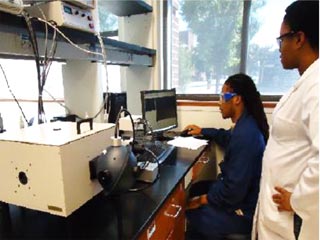AmericanChemicalSociety.com
- American Chemical Society
- Home
- Researcher Stories
Dr. Zerihun Assefa
 Associate Professor, Inorganic Chemistry
Associate Professor, Inorganic Chemistry
North Carolina A&T State University
Grant 47823-GB3
Disruption of Metal-Metal Interactions and Extended Linear Chains by Organic Solvent Molecules
Dr. Zerihun Assefa, Associate Professor of Inorganic Chemistry at North Carolina A&T State University, and his team are investigating methods to enhance energy transfer using the Group 11 elements (e.g., gold, silver, copper) on the Periodic Table. The Group 11 elements are of particular interest, because their spectral properties are relatively easy to manipulate.
Dr. Assefa’s initial interest in this research stems from his days as a graduate student when he became fascinated by coordination polymers—specifically of the Group 11 elements—and their spectroscopic behavior. In his graduate and subsequent post-doctoral studies, Dr. Assefa observed that, when introduced to an organic solvent, Group 11 systems crystalize, and there is evidence of a dimeric formation.
 The luminescence lab.
The luminescence lab.Through this crystallization process, the Group 11 materials seem to prefer a metal-metal interaction. (E.g., under influence from the organic solvent, gold atoms “like” to interact with other gold atoms to form extended linear chains.) Concurrently, the spectral properties—especially light emission properties—also change. How close or far the components of the metal-metal compounds are to each other in turn affects their light emission behavior. These distances can be altered through chemical and physical variations (e.g., applied pressure, temperature, solvent).
This dimeric formation is not observed when the organic solvent is removed. Dr. Assefa’s research focuses on the disruption of this metal-metal interaction and examines why this happens, with the hope of enhancing the rate of energy transfer.
An exciting development from Dr. Assefa’s research involves dual-donor enhancement. This involves the transfer of energy from two different excited donors to a single lanthanate ion for the purpose of enhancing light emissions from the lanthanate systems.
“In the presence of an organic solvent, the systems crystalize, and we see two molecules crystalizing in dimeric form. This dimeric nature is entirely removed when the organic solvent is absent from the system. Just how the solvent influences the directionality of the chain was a mystery to us.”
Lanthanates—a series of elements found at the bottom of the Periodic Table—are by nature weak emitters. Therefore, although lanthanate systems are extremely useful as sensor materials (sensing air pollution, for example), they must first be enhanced. Through dual donor sensitization, Dr. Assefa’s team is investigating how to stimulate emissions from lanthanates through interaction with the Group 11 and Group 10 elements.
Discovery of this dual donor enhancement has opened a huge and very productive research area for Dr. Assefa’s team, and it has led to a fruitful collaboration with a team led by a Professor Sykora at the University of South Alabama. Their combined efforts have produced more than 10 publications on this subject over the past two to three years.
Dr. Assefa credits PRF for jump-starting his research. PRF funding for allowing him to expand his research efforts, as well as to support the research activities of students on his team: two graduate one undergraduate. Dr. Assefa identifies the enthusiasm of his students for the research they are doing as one of the most rewarding aspects of his work. Much of his current and future research will focus on dual donor enhancement, as well as looking at materials used for white light emissions.
Dr. Zerihum Assefa has been an Associate Professor at North Carolina A&T State University since 2005. Originally from Ethiopia, Dr. Assefa came to the United States in the late 1980s. He received his Ph.D. from the University of Maine, then conducted post-doctoral studies at Texas A&M and Auburn University. He worked for 10 years at the Oakridge National Lab in Tennessee in the transuranium research group.
Copyright © American Chemical Society

